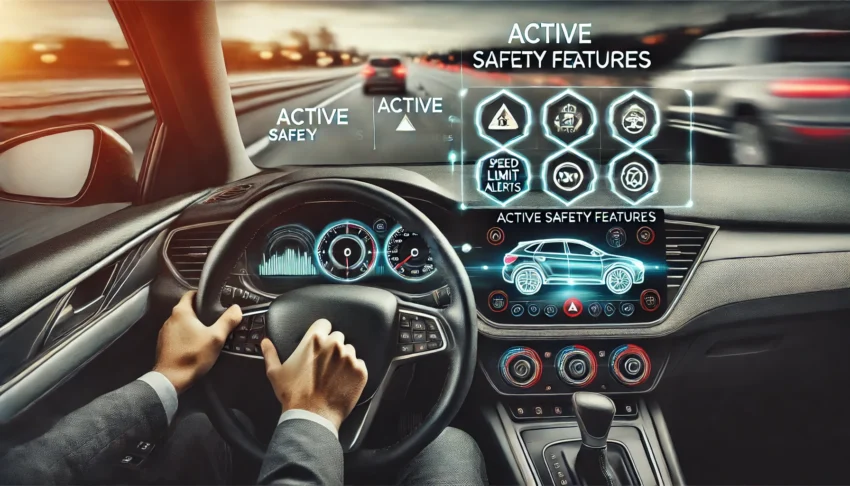Advanced safety features like lane departure warnings, lane keep assist, and speed limit alerts used to frustrate many drivers. These features often fell short of their promises, leading drivers to disable them. A new study by the Insurance Institute for Highway Safety (IIHS) indicates that drivers’ attitudes toward safety features are evolving. More drivers now leave these automated systems on, indicating a growing acceptance of advanced safety technologies.
Study Highlights Increased Use of Advanced Safety Features
The IIHS study analyzed data from over 2,000 vehicles serviced at dealerships around Washington, D.C. It focused on vehicles from model years 2017 to 2023, ensuring that most had some form of active safety feature. The study focused on the usage of systems such as front crash prevention, lane departure warnings, and visual speed alerts.
87% of Drivers Keep Lane Departure Systems On
One key finding of the study was that 87% of drivers now leave lane departure warning and prevention systems active. This is a significant increase compared to a similar study conducted eight years ago. At that time, only 51% of drivers kept these systems turned on. The findings also revealed that merely 1% of the vehicles had warning systems without active lane departure prevention capabilities.
This detail is crucial because active lane departure systems can prevent up to 23% of fatal passenger vehicle crashes, according to the IIHS. The shift toward active systems means a greater potential for improving road safety.
High Usage of Collision Warning and Automatic Braking Systems
The study also revealed that 94% of vehicles had their forward collision warning or automatic emergency braking systems enabled. This high usage rate may be because these systems are harder to turn off than lane-keeping features. In many vehicles, software-based controls manage these systems through the infotainment screen. Drivers are less likely to disable them compared to systems controlled by physical buttons.
Drivers Embrace Visual Speed Warning Systems
Another notable finding was the widespread use of visual speed warning systems. Nearly 70% of surveyed vehicles had this feature activated. This is encouraging, especially since these systems are relatively new to the U.S. market. The IIHS believes that this high rate of use could positively impact driving habits over time.
Why Are Attitudes Changing?
So, what’s causing this shift in driver behavior? Aimee Cox, the lead author of the IIHS study, believes that two factors are at play: better-designed systems and growing acceptance of crash avoidance technologies.
“The results reflect a combination of improved designs and increased acceptance of crash avoidance systems,” Cox stated. “The new designs are less annoying for the driver and a bit harder to turn off.”
Improvements in Design Make a Difference
Advancements in vehicle safety systems have greatly improved their functionality and reliability. Early versions were often overly sensitive and intrusive, leading to frequent false alarms. Automakers have since worked to make these systems less disruptive, with fewer false alerts and better integration into the driving experience. These improvements have led to higher usage rates and more driver acceptance.
More Effective Systems Through Software-Based Controls
The study also notes that safety features integrated into the infotainment system are less likely to be turned off. In contrast, systems with physical buttons are easier to disable, resulting in lower usage rates. By embedding these features into software controls, manufacturers help ensure that safety systems stay active. This approach can ultimately lead to a decrease in crash rates.
The Potential Impact of Speed Warning Systems
IIHS President David Harkey expressed optimism about the impact of speed warning systems. “The increased acceptance of lane departure prevention should lead to larger reductions in crash rates,” Harkey explained. “The same positive trend could happen with anti-speeding alerts. These results show they are already more popular with drivers than some experts expected.”
The widespread acceptance of these features suggests that drivers see the benefits, particularly in maintaining safer speeds.
The Future of Road Safety
The results of the IIHS study are promising. Increased use of lane departure, forward collision warning, automatic braking, and speed warning systems shows a shift in how drivers view automated safety technologies. Although some drivers previously found these systems frustrating, better designs and integration have made them more acceptable.
The more drivers use these features, the more potential there is for reducing accidents and fatalities. Active safety systems play a crucial role in preventing crashes. Their growing presence on the road is a positive sign for overall road safety.
Conclusion
Drivers’ attitudes toward advanced safety features are changing. As the IIHS study reveals, most drivers now leave systems like lane departure warnings, forward collision warnings, and speed limit alerts activated. Improved design, less intrusive alerts, and harder-to-disable features have contributed to this trend. As acceptance of these technologies grows, they could significantly reduce crash rates and enhance road safety.
FAQs
Why did drivers turn off safety features in the past?
Older systems were often too sensitive or intrusive, resulting in frequent false alarms that annoyed drivers.
What percentage of drivers now keep lane departure systems on?
According to the IIHS study, 87% of drivers keep lane departure warning and prevention systems activated.
Are visual speed warning systems widely used?
Yes, nearly 70% of vehicles in the study had visual speed warning systems enabled, showing growing acceptance.
Why are newer safety systems harder to turn off?
Many systems are integrated into the infotainment software, making them more challenging to disable compared to physical button controls.
What impact do active lane departure systems have on road safety?
The IIHS states that active lane departure systems have the potential to prevent up to 23% of fatal passenger vehicle crashes.

